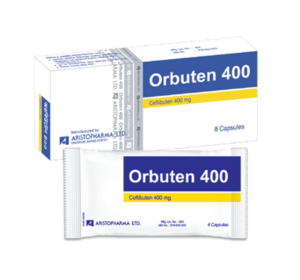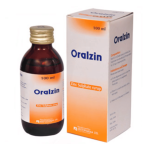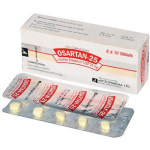Orbuten (Ceftibuten)

Therapeutic Group : Antibiotic
Presentation:
Orbuten 400 Capsule: Each capsule contains Ceftibuten Dihydrate INN equivalent to Ceftibuten 400 mg.
Orbten Suspension: Each 5ml suspension contains Ceftibuten Dihydrate INN equivalent to Ceftibuten 90 mg
Pharmacology:
Microbiology: Ceftibuten exerts its bactericidal action by binding to essential target proteins of the bacterial cell wall. This binding leads to inhibition of cell-wall synthesis. Ceftibuten is stable in the presence of most plasmid-mediated beta-lactamases. Ceftibuten has been shown to be active against most strains of the following organisms both in vitro and in clinical infections- Gram-positive aerobes: Streptococcus pneumoniae (penicillin-susceptible strains only) Streptococcus pyogenes. Gramnegative aerobes: Haemophilus influenzae (including beta-lactamase-producing strains). Moraxella catarrhalis (including beta-lactamase-producing strains). Pharmacokinetics: Ceftibuten is generally absorbed after oral administration. Plasma protein binding of ceftibuten is 65% which is independent of plasma ceftibuten concentration. It shows good concentration in different tissues: of plasma concentration, 15% in epithelial lining fluid, 37% in bronchial mucosa, 7% in sputum, 70% in mid-ear fluid of the plasma concentration. Cis-ceftibuten is the predominant component of ceftibuten in both plasma and urine. About 10% of ceftibuten is converted to the trans-isomer. Approximately 56% of the administered dose of ceftibuten is recovered from urine & 39% from feces within 24 hours.
Indications:
Ceftibuten is indicated for infections caused by susceptible microorganisms: 1) Acute Bacterial Exacerbations of Chronic Bronchitis 2) Pharyngitis and Tonsillitis 3) Acute Bacterial Otitis Media. Ceftibuten is also effective in treating urinary tract infection, pneumonia, enteric fever, gastroenteritis etc.
Dosage & Administration:
For Adult (12 years and older): The recommended dose of ceftibuten is 400 mg once daily for 10 days. For children: The dose is 9 mg/kg body weight once daily for 10 days. For renal impairment: For the patients with creatinine clearance of 50 mL/min or, greater normal dose should be administered. The recommended dose for renal insufficiency patients is given in the following table.
Contrainidications:
Ceftibuten is contraindicated to patients with the history of hypersensitivity reactions to ceftibuten, other cephalosporins & penicillins.
Warning & Precautions:
If superinfection occurs during therapy, appropriate measures should be taken. The dose may require adjustment, particularly in patients with creatinine clearance less than 50 mL/min or undergoing hemodialysis.
Side effects:
Nausea, headache, diarrhea, abdominal pain, dyspepsia etc. may occur.
Drug interaction:
Theophylline: The pharmacokinetics of theophylline was not altered during coadministration with ceftibuten. Antacids or H2-receptor antagonists: A single dose of liquid antacid did not affect the Cmax or AUC of ceftibuten; however, 150 mg of ranitidine q12h for 3 days increased the Cmax of ceftibuten by 23% and AUC by 16%.
Use in special groups:
Use in pregnancy: Pregnancy category B. This drug should be used during pregnancy only if clearly needed. Use in nursing mothers: It is not known whether ceftibuten (at recommended dosages) is excreted in human milk. Because many drugs are excreted in human milk, caution should be exercised when ceftibuten is administered to a nursing woman.
Use in pediatric patients: The safety and efficacy of ceftibuten in infants less than 6 months of age have not been established.
Use in geriatric patients: The usual adult dosage is recommended. However if renal function is hampered, dosage adjustment may be required.
Packing:
Orbuten 400 Capsule: Each box contains 8 capsules in Alu-Alu blister in Alu-Alu pillow pack
Orbten Suspension: Each 5ml suspension contains Ceftibuten Dihydrate INN equivalent to Ceftibuten 90 mg



